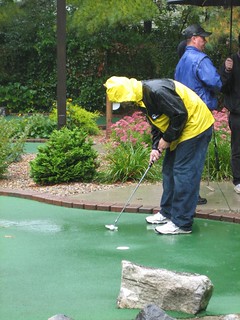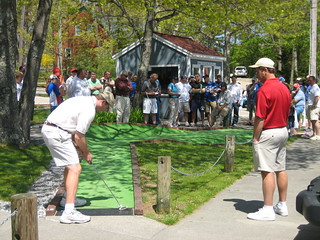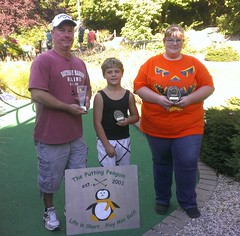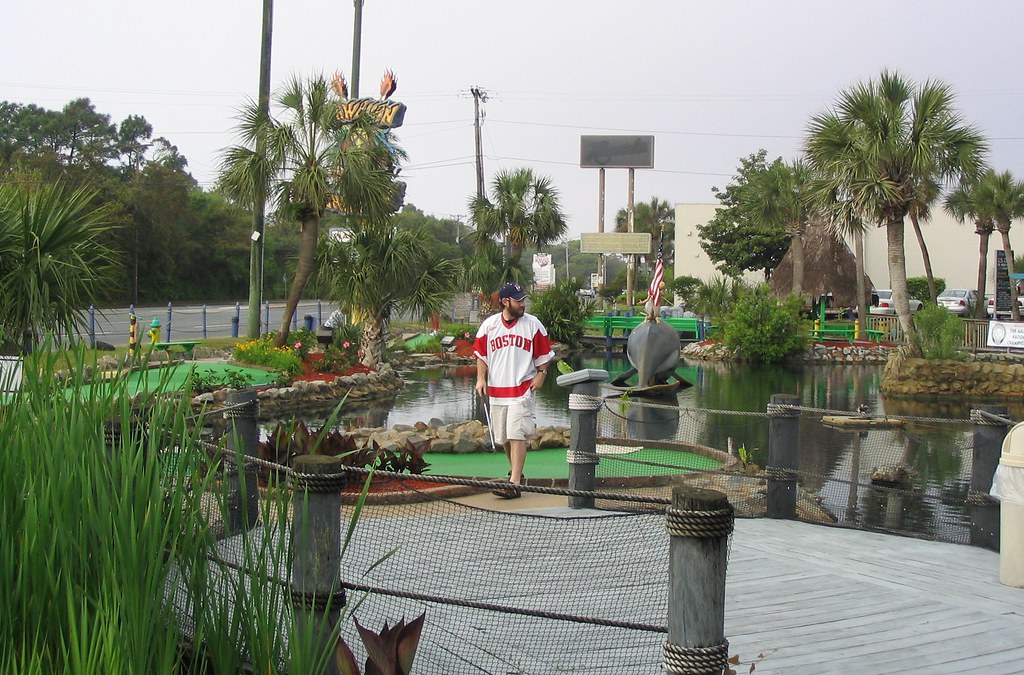Waddling to the Top
The Skills for Winning
by Pat Sheridan on 04/23/15
We're 23 days away
and I still haven't lifted a putter.
Fear not though, it looks like there is a round or two in my near future
with a fellow professional miniature golfer.
I'm also a mere four posts into my blogging life and I already have a correction to make. In my previous post where I talked some about gender equality in miniature golf, I failed to mention the other golfer that KPMG sponsors, Stacy Lewis of the LPGA (only one of the best female golfers). Maybe someday KPMG will put something together where I can play both Stacy ad Phil on the mini-links.
While your focus doesn't always need to be on winning a tournament, the skills for winning are also the ones you'll need to have a good tournament experience and a decent showing in your scores. It's always easier to have fun at a tournament when you feel like you're playing your best. There are four things you need to be a good miniature golfer: putting skill, course knowledge, physical fitness and mental fitness.
Putting Skill: There is no doubt about it - you need to have some sort of skill with the putter to do well in a tournament. The other three factors are about preparation. This one is about execution. If you can't put together the aim, swing, contact and follow through, you are going to have a long day. The good thing, I think, is that putting is easier to improve than driving a golf ball or enhancing your wedge shots. The movements are more controlled, the speed of the club is less and it is something you can work on in your living room. But don't think all you need is some time on the practice green or playing a lot of regular golf. Putting in minigolf is slightly different than "big" golf as the putting surface is quite different and you have added factors such as obstacles and brick bounce. More good news - spending more time on the minigolf course to refine your skills is pretty easy since you can bring your family along too!
Course Knowledge: I'll talk more about preparing for a course in a future post but as G.I. Joe said "knowing is half the battle". Just like you need to know where to hit your drive in golf so it doesn't go in the water or whether a green is protected by bunkers, you have to know what a minigolf course is hiding. It's not just knowing about the breaks of the putts either. You need to know which brick is going to give you the right bounce or which one has defect that might send your ball flying. You need to know how the course changes in the rain, since we'll play in it. You need to know where to tee your ball to get the best angle at the hole. Lisa Simpson was dead on when she was figuring out all the angles for Bart; you'll have to do the same (yes - you should have paid attention in geometry class).

Josh Tiberio playing in the rain in the 2006 Odetah Fall Classic
Physical Fitness: Laugh all you want but a USPMGA miniature
golf tournament is going to kick your butt. Let's assume you play a ten round
tournament and take ten rounds of practice.
At a minimum you're taking 720 putts (assuming 2 per hole) over three to
four days. That’s 720 times you have to
bend your knees and swing your arms.
It's 360 times you'll have to bend over the place the ball and 360 times
you'll have to retrieve the ball from the hole.
It's 20-30 hours of being on your feet in the sun, wind, rain, heat and/or
cold. It's not so much a test of your endurance or strength as it is a test of
your joints. Now, I don't want to oversell it and make it seem like you're running
a marathon but don't be
surprised if your knees and back twinge by the end of a tournament. In the end though, I'm an accountant with the
physical fitness of a beluga whale so there's a good chance that your body can
withstand the punishment.
Mental Fitness: A tournament will test your ability to keep focused and not to lose your cool. There's nothing worse than missing an easy deuce putt, turning that into a four on that hole and then immediately following it up with another three or four on the next holes. You're going to take 360 putts in a USPMGA tournament; chances are at least one of them is going to suck. It's how you deal with those disappointing putts that will determine how well you do in the tournament. It is one thing to tell yourself, or a friend, to "shake it off," it's another thing to do it in practice when every putt counts. You may not think a minigolf tournament can be stressful but when it comes down to sinking putts to seal your ranking, it's easy to fall into the intensity of the moment.
Master those four areas and you'll be a respectable professional miniature golfer!
What's in a tournament? (Part II)
by Pat Sheridan on 04/18/15
I guess it is fitting that this post comes mere days after a Bones episode about the death of a professional miniature golfer. I hope I'm not in for the same fate! My tournament preparation at 27 days out consists of zero putting but does include a cider and cigar on my deck.
USPMGA tournaments follow a similar path of a local tournament but there are more rules governing equipment and play. For those players who jump from local tournaments, or never have played in a local tournament, playing in a USPMGA tournament could be a shock if you aren't prepared.
Cost and Duration: To play in a USPMGA tournament you first need to be a registered USPMGA player, which costs $25-$40 a year depending on when you send in your fees (due each year by Feb 1). Entry fees are usually $50 - $150. The duration will vary but 8 to 10 rounds of stroke play is normal and played over at least two days.
Divisions: There is usually multiple divisions including amateur, seniors and womens. Sometimes they are separate tournaments and other times they are sub-divisions within the main professional division, since there is nothing keeping people from all persuasions playing in the main event. One of the great things about miniature golf is that women and men do play in the same tournament and there's nothing keeping them from being on equal footing. However, the number of women who play in USPMGA events isn't as high as it should be.
Purse: The U.S. Open this year will have a cash purse of at least $8,000 and the Masters will have $12,000. There are smaller UPMGA tournaments ($2,000 - $5,000 total purses) but in general there's good money on the line. I don't do it for the money but it doesn't hurt to walk away with some cash.
Competition: The U.S. Open will feature at least 20 of the best miniature golfers in the United States and some from around the world. The smaller USPMGA tournaments will have not quite as many but still a high level of competition for the top spots. There will also be a good amount of folks entering who are local to the course and like in a local tournament, they give everyone a run for their money because of their knowledge of the course. I would love it if we could convert every "local" player to a USPMGA player though to grow our ranks.
Equipment: The official ball of the USPMGA is the Calloway Hex Chrome with the USPMGA logo on it. Only those balls can be used in USPMGA tournaments. I find it kind of dumb that players can't select their own brands the way some in the PGA would but I am not the one running the show. Luckily, they don't decide what types of putters we can use. I use a Calloway White Hot blade putter. I like the blades because on those rare occasions when you need to make a left-handed shot, it's not impossible to do like if I had a ball putter.
Clothing: There's rarely a dress code in a local tournament other than what is the normal code at the course of shirts and shoes. I've been known to wear jerseys of many sports (hockey, baseball, football, cricket, etc) at these tournaments ala Happy Gilmore. The USPMGA, however, expects a little more class. You have to wear closed toe shoes (i.e. – no sandals) and a collared shirt as a man. For me this means a combination of The Putting Penguin and KPMG (my employer and sponsor of Phil Mickelson) shirts and a corresponding hat.

Me rocking a USSR hockey jersey during a tournament in Maine in 2006
Play: In my experience it seems like the pairings in the USPMGA tournaments are based on skill level versus random match ups. There is a benefit to playing someone at your same level and in a future post I'll discuss what you should do if you're lucky enough to be paired with someone better than you. Similar to local tournaments, play is honors and the rounds are played in groups. For example, you might play 3 rounds in the morning, get re-paired and play 3 rounds in the afternoon before being re-paired again the next day. Many times a tournament will also repair for the final round so the top players go against each other while the rest of us get to watch some excellent minigolf after we finish.
The rules are set by the USPMGA and like a local tournament will cover aspects such as where to tee off, how much you can move the ball off the wall and what to do when the ball goes out of bounds. Players will keep each other's scores and turn in the scores at the end of the each round, most of the time signing the scorecards just like in the PGA.
One big difference in the USPMGA tournaments is the crowds, in that there tends to be some. We don't get Masters' level galleries but there can be a few spectators from the area and often a local news organization or two will show up for the larger tournaments. As a mid-level player I'm hardly in the spotlight but it's great to see our sport getting press.

Matt McCaslin playing the final hole with a crowd in the 2008 U.S. Open
Scores: One thing we didn't talk about in the local tournaments was the winning scores. The totals always vary based on the course but in almost all cases you are looking at scores averaging less than 3 per hole. USPMGA events become even tougher on the scores with many having winning scores of less than 2 shots per hole (or under 36 per round). In fact when you ask a USPMGA player about "par" on a course, we always assume everything is a par 2 and we're always shooting for aces. Don't be intimidated though – we'll talk in future posts on how to get your scores down!
Ready to play yet?
What's in a tournament? (Part I)
by Pat Sheridan on 04/16/15
Its T-minus 30 days to US Open and my current preparation status is that I haven't used my putter in over a month. I've also decided airports need to install indoor minigolf courses.
The biggest question I get about miniature golf tournaments is "What goes on at one of those?" In some ways it depends on whether you are talking about a local tournament or a USPMGA tournament. (I won't speak about Putt-Putt/PPA tournaments as I have never played in one and they seem to be a third kind of beast or international competitions since the same inexperience applies. I'm also skipping "charity" tournaments where the focus is solely on raising money for a cause and not the competitive side of the sport).
Since I would highly recommend you playing a local tournament before diving into a USPMGA one, let's start with what you might expect there. My next post will cover the USPMGA details. The great thing about a local tournament is that they come in all shapes and sizes. The bad thing is that variety makes it hard to easily describe what to expect, but I'll do my best to generalize.

The Putting Penguin's Mandy Ranslow playing in a local tournament with Josh Tiberio
Cost and Duration: Most are $10 - $50 to enter. They can be of varying length, with the more expensive being longer, but in general they'll be between one and four rounds of stroke play, with the lowest total score taking home the cash.
Divisions: Most small tournaments don't do multiple divisions or at most they may have a separate kid's tournament. However, some tournaments will do different divisions for different skill levels and they may have different entrance fees and payouts.

2013 Odetah Fall Classic division winners
Purse: A local tournament won't pay much and you may only get a trophy. However, some tournaments will pay up to a couple hundred dollars for first place and pay out through the top four or more places. In the tournament we run, we've always tried to make the purse graduated so 1st place was a large bump over 2nd and 4th place at least won your entrance fee back. But one thing to remember about local tournaments and USPMGA tournaments, you're focus should always be about having fun and enjoying the game and not how much money you win.
Competition: There could be a handful of professionals depending on where the tournament is but a majority of the players will be locals who only play in that tournament each year. While playing against the pros is always tough, the locals present major challenges in these tournaments. They play the course many times during the year and know all of the quirks. Plus they feel comfortable on the greens which gives them confidence to play against the best.
Equipment: You always have the choice of using the course putters and balls but I would suggest not doing that if you can avoid it. The putters can be chipped and uneven and the balls are usually worse for wear. I've never been at a tournament where you can't use your own putter but I have been at a couple where you have to use the course balls. Otherwise you’re allowed to use your own and I favor a Titleist ball, with The Putting Penguin on it, given my familiarity with how it plays and bounces off bricks.
Play: You will generally be grouped in pairs randomly, but some tournaments do threesomes or foursomes, and have a shotgun start (each group starting at a different hole). This ensures everyone finishes rounds at roughly the same time to keep the tournament going. But like everything else, some tournaments will have everyone start on hole 1 and play through a straight 18. Depending on the tournament you might play the whole time with that same group, finishing one round after another, or you may be re-paired after a set of rounds so that folks with similar scores play the final rounds together.
During the actual round, you normally "play through" or "hole out" each hole. This means that instead of letting everyone hit their tee shot and then rotating through the remaining shots, each player plays through the complete hole before the next player goes. This ensures that another player's ball never gets in your way. The rules are set by the course but most often involve space you can pull the ball from the wall (6 inches or a scorecard length in most tournaments), how to handle a ball out of bounds (sometimes a penalty and play from where it went out and sometimes return to your original position without a penalty) and what to do if your ball gets stuck in a tube or obstacle (varies depending on the situation). The rules can sometimes get creative depending on the size and seriousness of the tournament.
You will play honors throughout the round (where the person with the lowest score on the last hole goes first on the next hole) and an important part is that players keep each other's score. This promotes honesty throughout the round plus it ensures that scores get recorded appropriately (you wouldn't believe how easy it is to forgot what you just scored on a hole). At the end of the round, players turn in their scorecard, grab another one and head out for another 18. It's all quite easy!
Next post we'll dive into the differences when playing a USPMGA tournament.
The Check is No Longer in the Mail
by Pat Sheridan on 04/11/15

My entry fee has been cashed and the receipt is in my inbox.
Entry fee to what?
The U.S. Open of Miniature Golf of course.
Wait, what? And why are you blogging?
The answers to both of those are tied together It's true, The Putting Penguin is not known for blogging. We leave that to the most famous bloggers in the miniature golf world. Our main focus is providing a website dedicated to miniature golf course reviews. However, part of our miniature golf experience is also playing in tournaments. While we focus on the family atmosphere and the accessibility of miniature golf for everyone, we also want to be part of the competitive side of the sport.
So we'd thought it would be fun to give you insight into the preparation and tournament experience of an everyday auditor who also happens to be a professional miniature golfer. For the next five weeks I'll be providing insight into what miniature golf tournaments are all about, tournament preparation, traveling to the course, pre-tournament practice and of course day of tournament thoughts.
To start our journey you should learn about me, your humble miniature golfer. For those of you familiar with The Putting Penguin, you know that Mandy and I started our miniature golf reviews in 2001 and have grown from that first review into the world’s largest miniature golf course review website. It was a scant two years later that we played in our first miniature golf tournament - the Mini Greater Hartford Open at Blue Fox Walk in Simsbury, CT. From there a love of competition was born. While Mandy will play in tournaments from time to time, I represent The Putting Penguin more often in tournaments. Most of what we play is local but we've both competed in a handful of United States Professional Miniature Golf Association (USPMGA) tournaments.

Playing in my first US Open in 2014
My first USPMGA U.S. Open was in 2004, just a year after I started competitively playing. It was held in Myrtle Beach over three different courses that I had never played until the day before the tournament began. I was an inexperienced as both a player and on the courses and the results reflected that. I finished in 25th. I returned to the U.S. Open field when the tournament was held on one of my favorite courses, Dolphin Minigolf, and was able to boost my way up to 13th. Locations and other factors kept me away for 6 more years until triumphantly returning to the U.S. Open scene with a 12th place finish in 2014 at Bluegrass Minigolf, after a underwhelming day 1. My day 2 rounds were up there with the best players in the tournament. This year, I travel to NC with the goal of increasing my personal best and hopefully cracking the top ten.
To date, I've played in 36 tournaments (both USPMGA and local) and had a great year in 2011 where I won 3 of them. My highest finish in a USPMGA tournament is 5th. All this leads to a whopping career earnings of $1,710 (stay in school kids). While most people still associate me primarily with The Putting Penguin (not a bad thing by any means and a fact I play up with my tournament clothing), I'd like to think that over the years I've earned some respect from the more hardcore players on tour as being a true professional miniature golfer. My focus on the "game" of minigolf will always be greater than the "sport" of minigolf, so while I might never be among the world’s best, I'm happy that I’m at least within striking distance in most tournaments.
The important thing to remember as you read about my journey over the next 5 weeks is that you can do this too. The total cost to enter the U.S. Open is less than $150 (dues plus entry fees) and you can make a vacation out of the trip. We'll talk in future posts about the skills needed to play in a tournament but they are accessible to everyone, especially those who already have a love of golf. I'm not saying you’ll walk onto the greens and be able to putt past Matt McCaslin, Brad Lebo or Olivia Prokpova in your first tournament (or your 50th) but you can earn respectable finishes and be able to call yourself a professional miniature golfer. What could be better than that?
Pat Sheridan
Co-Founder of The Putting Penguin
Auditor by day, Professional Miniature Golfer by night
